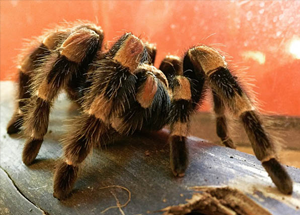
- VisitSupport Happy HollowDONATE TODAYExploreSupport Happy HollowDONATE TODAYLearnSupport Happy HollowDONATE TODAYSupport
-
Today's Hours: 10:00 am to 4:00 pm
Education AmbassadorsRed-kneed tarantula

Scientific name: Brachypelma smithi
Family: Theraphosidae
Order: Araneae
Class: Arachnida
Range: Pacific and Western Mexico
Habitat: Tropical Forest
Lifespan: Males up to 5 years; females up to 30 yearsWhat do they look like?
Spiders may look like creepy crawly bugs, but they are not insects at all! Tarantulas are arachnids, a class containing tarantulas, spiders, scorpions, ticks and mites. Like all arachnids, Red-kneed tarantulas have an exoskeleton, two main body parts, eight multi-jointed legs, two pedipalps (food-handling appendages), and two chelicerae (mouth parts). These tarantulas have black bodies with reddish-orange patches on the joints of their legs. There are eight light sensitive eyes located on the top surface of the cephalothorax (area between head and thorax) that sense light. Females are noticeably larger than males, reaching a leg span of up to six inches. This is a slow-growing species, taking up to 10 years for them to reach adult size.How do they behave?
Red-kneed tarantulas are solitary and territorial. They live in burrows and build platform webs (webs spun on the ground). Their burrows provide relatively constant temperature and humidity, as well as safety from predators. Tarantulas do not breathe the same way we do. They have lungs called book lungs. Instead of inhaling and exhaling, oxygen transfer is passive, occurring when air flows over the book lung. This process causes tarantulas to lose water through evaporation. It is critical that humidity levels remain relatively high in their burrows to prevent dehydration. With each molt (the shedding of the exoskeleton) urticating hairs (bristles or irritating hairs) develop on the abdomen. These hairs and can be kicked off by the tarantula onto a predator where the hairs then embed into the other animal’s skin or eyes, causing irritation.What do they eat?
Tarantulas cannot digest solid food. They must first inject venom into their prey which liquefies the insides. After this process is complete, the tarantula then slurps out the resulting fluid. In the wild, red-kneed tarantulas eat insects, small lizards, frogs, and other spiders. At Happy Hollow, they eat crickets.How are they born?
When a male approaches a female’s burrow, the male will tap and vibrate his legs to lure the female out. If the female is receptive, she will allow the male to mate with her. If she is not receptive, she will see him as a food source. Even after breeding, if the male does not leave quickly enough, he may be in danger of being eaten. After mating, the female will lay up to 1,000 eggs, which will hatch roughly one to two months later.Conservation
The red-kneed tarantula’s conservation status is currently listed as Near Threatened by the International Union for Conservation of Nature . Red-kneed tarantula populations are at risk due to a combination of factors such as capture for the exotic pet trade and habitat loss. You can help red-kneed tarantulas by leaving these beautiful animals in the wild, rather than taking them home as pets. If you want to take your conservation action a step further you can help protect the red-kneed tarantula’s wild cousins right here in California! California is home to several species of tarantula, all of which can benefit from water conservation. By simply turning off the faucet while brushing your teeth, or taking shorter showers you can save your money and help our native tarantulas. For more tips on how to save water visit www.saveourwater.com
Zoo on the Hill
Located across from the Keep-Around Carousel is the Zoo on the Hill. Learn about wildlife up close during daily meet-and-greets, leap like a lemur on the playground, brush and feed the goats,, or take a peek inside Doc’s Critter Care building and the Ranch House. Double-H Ranch features a combination of animal exhibits, including giant anteaters and red ruffed lemurs, as well chickens and domesticated animals that are docile enough to touch.

Zoo in the Hollow
Follow the crooked bamboo pathway down into the hollow and visit with some of the most amazing animals in the world. Where else in San José can you get up close to a stunning jaguar, lemur, meerkat or American alligator? Happy Hollow is dedicated to helping save species and preserve wildlife for future generations by participating in Species Survival Plan programs through the Association of Zoos and Aquariums.